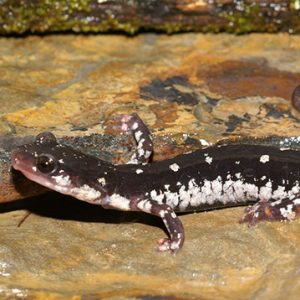calsfoundation@cals.org
Fourche Mountain Salamander
aka: Plethodon fourchensis
The Fourche Mountain salamander (Plethodon fourchensis) is a slender, large (115–178 millimeters in total length) terrestrial salamander that is one of twenty or so members of the caudate family Plethodontidae that can be found in Arkansas. This species is one of three endemic salamanders known to exist in Arkansas and is confined to Fourche Mountain and Irons Fork Mountain in the south-central region of the Ouachita Mountains. Normally, these salamanders can be found beneath the surface rock of hillsides and valleys within these mountains; however, they can also be found under rotting logs on the forest floor.
Adults of this species possess two longitudinal rows of large, white blotches on the back; the dorsal body color is, otherwise, uniformly black. The lateral body and head surfaces are creamy white in appearance; the tail exhibits scattered white spots. Juveniles may lack much of the lateral body coloration. The throat region is distinctly pale or white.
Little is known about the biology of this salamander. The highest concentrations of individuals are normally observed during the months of April and May. They are especially abundant immediately after periods of heavy precipitation. Following the spring mating season, adult females descend into the crawlspaces deep within the rocky substrates by early June; no nesting females of this species have been observed, however. Females are known to exhibit a biennial (every other year) reproductive cycle, but no information is available for clutch size.
As is the case with other large plethodontid salamanders of the Ouachita Mountains related to P. fourchensis, which includes the Caddo Mountain salamander (Plethodon caddoensis) and the Rich Mountain salamander (Plethodon ouachitae), the Fourche Mountain salamander is infested with chiggers (the larval trombiculid mite of the species Hannemania dunni), especially on the legs, feet, and toes. Surprisingly, chiggers do not infest the western slimy salamander (Plethodon albagula), an ecological associate.
Fourche Mountain salamanders probably feed on a variety of invertebrate species that occur within their microhabitat niche; ants and beetles, however, are known to constitute most of the diet of P. albagula in the Ouachita Mountains.
Chemical communication serves several vital functions in the Fourche Mountain salamander. For example, secretions released from the mental gland located under the chin of males help drive courtship responses in reproductive females. In addition, secretions from this prominent gland probably play a role in establishing territorial boundaries among conspecific males. Gland size changes with the seasons, usually corresponding with annual courtship activities.
Genetic studies of the Fourche Mountain salamander have indicated the presence of four geographically structured lineages. Each lineage appears to have responded to major physiographic features associated with valleys and mountain gaps within these mountains. Moreover, other related plethodontid salamanders (Plethodon caddoensis and Plethodon ouachitae) in the nearby Ouachita Mountain highlands have undergone different genetic divergences.
For additional information:
Duncan, R., and R. Highton. “Genetic Relationships of the Eastern Large Plethodon of the Ouachita Mountains.” Copeia (1979): 95–110.
Shepard, D. B., and F. T. Burbrink. “Phylogeographic and Demographic Effects of Pleistocene Climatic Fluctuations in a Montane Salamander, Plethodon fourchensis.” Molecular Ecology 18 (2009): 2243–2262.
Trauth, Stanley E., Henry W. Robison, and Michael V. Plummer. The Amphibians and Reptiles of Arkansas. Fayetteville: University of Arkansas Press, 2004.
Trauth, Stanley E., and J. D. Wilhide. “Status of Three Plethodontid Salamanders (Genus Plethodon) from the Ouachita National Forest of Southwestern Arkansas.” Journal of the Arkansas Academy of Science 53 (1999): 125–137. Online at http://libinfo.uark.edu/aas/issues/1999v53/v53a21.pdf (accessed September 7, 2021).
Stanley E. Trauth
Arkansas State University
 Amphibians
Amphibians Fourche Mountain Salamander
Fourche Mountain Salamander  Fourche Mountain Salamander
Fourche Mountain Salamander  Fourche Mountain Salamander
Fourche Mountain Salamander 



Comments
No comments on this entry yet.